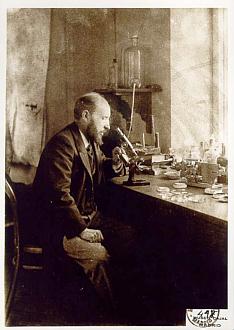산티아고 라몬 이 카할
스페인의 신경과학자
산티아고 라몬 이 카할(스페인어: Santiago Ramón y Cajal,[1] 스페인어: [sanˈtjaɣo raˈmon i kaˈxal]; 1852년 5월 1일 ~ 1934년 10월 17일)은 스페인 출신의 신경조직학자이다. 뇌의 미세구조에 대한 그의 선구적인 업적으로 말이암아, 흔히 근대 뇌과학의 아버지라고 일컬어진다. 뇌의 조직학적 구조를 그린 그의 숙련된 소묘 자료는 오늘날에도 뇌과학 교재로 사용될 정도이다.[2]

| |
| 출생 | 1852년 5월 1일 스페인 나바라 |
|---|---|
| 사망 | 1934년 10월 18일(82세) 스페인 마드리드 |
| 주요 업적 | 근대 뇌과학의 아버지 |
| 분야 | 신경과학 조직학 |
1906년 카밀로 골지와 함께 노벨 생리학·의학상을 공동 수상하였다. 그는 스페인 출신으로 노벨상을 수상한 최초의 인물이 되었다.[3]
생애
편집이 문단은 비어 있습니다. 내용을 추가해 주세요. |
정치 및 종교적 견해
편집이 문단은 비어 있습니다. 내용을 추가해 주세요. |
발견 및 이론
편집연구
편집산티아고 라몬 이 카할은 카밀로 골지 밑에서 연구를 해 골지 염색 방법을 익혔다. 이것은 은 입자를 사용해 세포체를 염색하는 방법으로 [1] 보관됨 2013-01-11 - archive.today, 이 방법을 통해 그는 다양한 형태의 신경세포체를 관찰했으며 이를 그림으로 남겼다. 이러한 방대한 염색 자료들을 토대로 그는 뉴런이론을 제창했다.[4] 이는 당대의 카밀로 골지의 주장이었던 네트워크이론과 대립했으나, 후대에 뉴런이 직접 발견되면서 뉴런이론이 정론으로 채택받게 되었다.
구별
편집이 문단은 비어 있습니다. 내용을 추가해 주세요. |
사회 및 문화에서
편집이 문단은 비어 있습니다. 내용을 추가해 주세요. |
출판물
편집이 문단은 비어 있습니다. 내용을 추가해 주세요. |
그림 갤러리
편집-
First illustration by Cajal (1888) of the nervous system. (A) First page of the article. (B) Vertical section of a cerebellar convolution of a hen. (C) Cerebellum of an adult bird. (D) Higher magnification of (C) showing Purkinje cell. (E) Dendrite of the Purkinje cell.
-
Drawing of the neural circuitry of the rodent hippocampus. Histologie du Système Nerveux de l'Homme et des Vertébrés, Vols. 1 and 2. A. Maloine. Paris. 1911
-
Drawing of the cells of the chick cerebellum, from "Estructura de los centros nerviosos de las aves", Madrid, 1905
-
Drawing of a section through the optic tectum of a sparrow, from "Estructura de los centros nerviosos de las aves", Madrid, 1905
-
From "Structure of the Mammalian Retina" Madrid, 1900
-
Drawing of Purkinje cells (A) and granule cells (B) from pigeon cerebellum by Santiago Ramón y Cajal, 1899. Instituto Santiago Ramón y Cajal, Madrid, Spain
-
Drawing of Cajal-Retzius cells, 1891
-
Drawn in 1899, taken from the book "Comparative study of the sensory areas of the human cortex"
-
schema of the visual map theory (1898). O=Optic chiasm; C=Visual (and motor) cortex; M, S=Decussating pathways; R, G: Sensory nerves, motor ganglia.
-
Purkinje cell of the human cerebellum. Golgi method. -a, axon; b, recurrent collateral; c and d, spaces in the dendritic arborization for stellate cells, by Santiago Ramón y Cajal.(see Fig. 9 in Ref.[5])
같이 보기
편집각주
편집- ↑ 이 스페인어 이름에서 첫 번째 또는 부계 성은 Ramón이고 두 번째 또는 모계 성은 Cajal이다.
- ↑ “History of Neuroscience”. Society for Neuroscience. 2008년 5월 15일에 원본 문서에서 보존된 문서. 2008년 10월 9일에 확인함.
- ↑ Interesante, Muy (2019년 10월 17일). “Los premios Nobel españoles” (스페인어). 2020년 5월 1일에 확인함.
- ↑ Ramon y Cajal, Santiago. 《Neuron Theory or Reticular Theory ?》.
- ↑ Santiago Ramón y Cajal, "Texture of the Nervous System of Man and the Vertebrates, Volume 1" Originally published by Springer-Verlag Wien New York in 1999
외부 링크
편집- Fishman, R. S. (2007). “The Nobel Prize of 1906”. 《Archives of Ophthalmology》 125 (5): 690–694. doi:10.1001/archopht.125.5.690. PMID 17502511. (Review of the work of the 1906 Nobel Prize in Physiology or Medicine winners Camillo Golgi and Santiago Ramón y Cajal)
- 산티아고 라몬 이 카할 - Nobelprize.org including the Nobel Lecture on December 12, 1906 The Structure and Connexions of Neurons
- Ramón y Cajal, Santiago (1906년 12월 12일). “The structure and connexions of neurons” (PDF). 《The Nobel Prize》. 2022년 4월 2일에 확인함.
- Marina Bentivoglio Life and discoveries of Cajal Nobel Prizes and Laureates, 20 April 1998
- Cajal's Láminas ilustrativas Centro Virtual Cervantes
- Javier de Felipe Brief overview of Ramón y Cajal's career www.psu.edu The Pennsylvania State University, 1998
- Newspaper clippings about 산티아고 라몬 이 카할 in the 20th Century Press Archives of the ZBW
- Fields, R. Douglas (2017년 9월 28일). “Why the First Drawings of Neurons Were Defaced”. 《Quanta Magazine》.